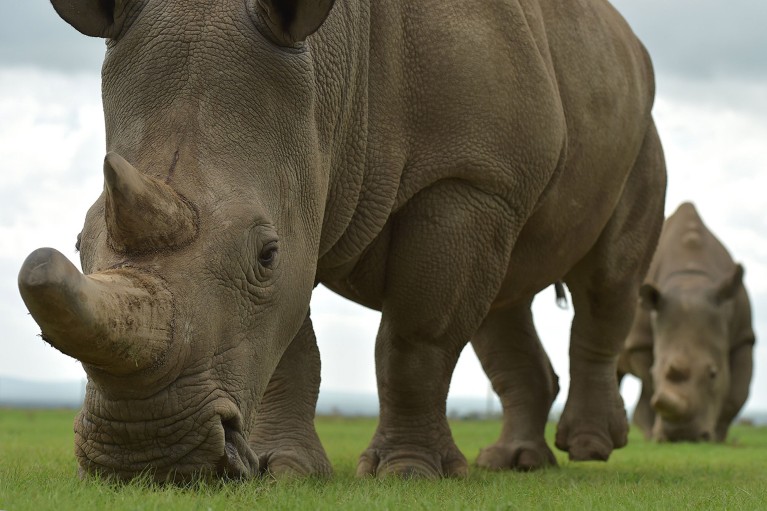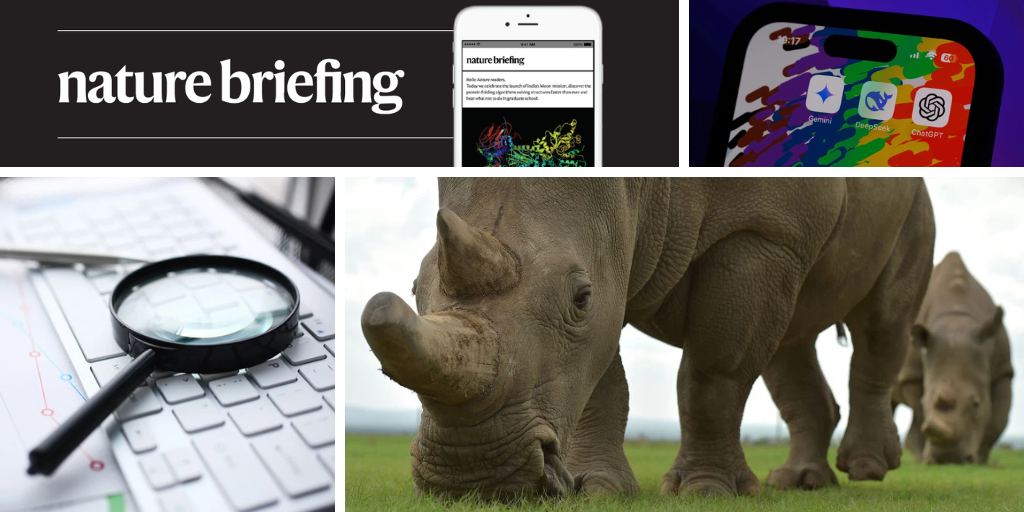You have full access to this article via your institution.
Hello Nature readers, would you like to get this Briefing in your inbox free every day? Sign up here.

Rhinos’ evolutionary relationships became a little clearer with the sequencing of the oldest proteins yet.Credit: Tony Karumba/AFP via Getty
Proteins extracted from the remains of an extinct rhino species (Epiaceratherium itjilik) are among the most ancient ever sequenced. From a sample of enamel from the 23-million-year-old fossil, researchers were able to partially sequence 7 proteins. Integrating these proteins with genome data places Epiaceratherium in a new branch of the rhino family tree — one that split off between 41 million and 25 million years ago. The findings suggest that proteins survive better than researchers thought. This raises the possibility of gleaning molecular insights about evolutionary relationships, biological sex and diet from even older animals — maybe even dinosaurs.
Reference: Nature paper 1 & paper 2
The work of scientific sleuths — people who uncover flaws and fraud such as fabricated data in research publishing with the aim of getting problematic papers retracted — is being used out of context to argue that science itself is broken, say several prominent sleuths. Image-integrity specialist Elisabeth Bik gives the example of US health secretary Robert F. Kennedy Jr, who seemingly referred to the retraction of a Nature paper as evidence that the theory that amyloid-β proteins cause Alzheimer’s disease is “fraudulent”. Bik worries that sleuths’ work is being “misused, or even weaponized, to convince the general public that all science is bad”.
The transition from a hunter-gatherer lifestyle to farming livestock spurred some of the first major zoonoses — the process by which humans catch diseases from other animals. An analysis of ancient human remains found that DNA from zoonotic pathogens, including those that cause leprosy and the plague, was only present in remains that were around 6,500 years old or less, around the time humans started living in settled communities in close proximity with livestock and horses.
o3, an artificial intelligence (AI) model developed by the creators of ChatGPT, is top dog when it comes to answering science questions across multiple fields, according to a new AI benchmarking platform. The platform, SciArena, ranked 23 large language models (LLMs) according to the quality of their answers to scientific questions, as voted on by 102 researchers. After more than 13,000 votes, o3 outperformed DeepSeek-R1 and Google’s Gemini-2.5-Pro at answering questions on natural sciences, health care, engineering, and humanities and social science.
Features & opinion
An intriguing class of super-sponge material invented more than 30 years ago is finally coming to market, with the goal of trapping carbon from the atmosphere. As the world’s most porous solid materials, these metal-organic frameworks (MOFs) can store gases, act as catalysts, trap toxic chemicals from water and deliver drugs. Chemists have struggled to find a commercial purpose since MOFs were invented in 1989 but now see carbon capture as a potential breakthrough application — a US$150 million-factory just opened in Canada aiming to capture 10 million tonnes of CO2 every year.

This metal-organic framework, named DUT-60, holds the record for the material with the biggest internal surface area at a whopping 7,839 square metres per gram — plenty of room to trap and store gases. (Adapted from mofanatomy.com)
In dogs, cancer develops and progresses faster than in humans. But genetically, a dog’s cancer and a human’s are very similar, often caused by the same mutations to the same stretch of DNA. These similarities mean that dogs with cancer make a pretty good proxy for studying the disease in people, from speedrunning clinical trials of new drugs to spotting chemicals that might be causing cancer. “It’s like having a mobile biosentinel organism that can help inform us about our own medical prospects over the next 25 years,” says geneticist Matthew Breen.
Knowable Magazine | 9 min read
In the past two years, “with surprisingly little notice, renewable energy has suddenly become the obvious, mainstream, cost-efficient choice around the world”, writes environmentalist Bill McKibben. For example, at one point in May in California, renewables were producing more than one and a half times the energy needed in the state — the world’s fourth-largest economy. The boom in solar and other renewables brings with it “a chance for a deep reordering of the earth’s power systems, in every sense of the word ‘power’”, argues McKibben. Unlike fossil fuels, “the sun and the wind are available everywhere”.
Today I’m wondering what I’d want my last meal to be. Usually, I run through my favourite foods and mull over what tastes and textures I might want just before I shuffle off this mortal coil. Now, I have one more element to consider — what I’d want future palaeontologists to discover about my diet if I’m fossilized.
Scientists recently confirmed that a flying reptile called a pterosaur (Sinopterus atavismus) had plants in its stomach when it died around 120 million years ago. The discovery shows that the winged reptiles weren’t always carnivores — they were partial to a leafy meal too.
Which modern culinary delights do you think would most confuse future palaeontologists? Let us know, along with your feedback on this newsletter, at [email protected].
Thanks for reading,
Jacob Smith, associate editor, Nature Briefing
With contributions by Flora Graham and Josh Axelrod
• Nature Briefing: Careers — insights, advice and award-winning journalism to help you optimize your working life
• Nature Briefing: Microbiology — the most abundant living entities on our planet — microorganisms — and the role they play in health, the environment and food systems
• Nature Briefing: Anthropocene — climate change, biodiversity, sustainability and geoengineering
• Nature Briefing: AI & Robotics — 100% written by humans, of course
• Nature Briefing: Cancer — a weekly newsletter written with cancer researchers in mind
• Nature Briefing: Translational Research — covers biotechnology, drug discovery and pharma


